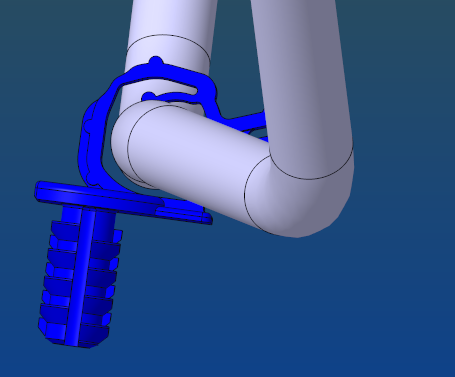-
-
January 4, 2024 at 9:50 am
Antony CHIDIAC
SubscriberHello, I'm trying to run a modal analysis on pipes that are "fixed" with flanges, though there is a gap between the flanges and the pipes, so the pipes are not really fixed and the pipe and flanges are not really in contact uless the pipe moves.
I want to take into consideration the gap because it represents the reality.
What do you think is the best approach for a modal analysis knowing that the pipe is not fixed where the flange is and that it can vibrate and its movement is limited by the flange.
-
January 4, 2024 at 10:53 am
Akshay Maniyar
Ansys EmployeeHi Antony,
Modal analysis is a linear analysis. So, it only supports bonded and no separation contact. You can use bonded contact with MPC formulation for non-uniform gap conditions.
If you want to consider the gap and model it closer to reality, then you will have to consider the loading which will close that gap, and then do modal analysis for that configuration of geometry. For example, if gravity is applied and it closes that gap, then you can first do the prestress analysis and then do a modal analysis for that prestress model.
For more details please check the below course on Modal analysis.
Modal Analysis in Ansys Mechanical | Ansys Courses
Thanks,
Akshay Maniyar
-
January 4, 2024 at 11:05 am
Antony CHIDIAC
SubscriberHello Akshay, thank you for your fast answer,
Is it possible to use the harmonic balance method instead and see if I can extract the modal frequencies?
Because the purpose is to simulate the gap and its effects on the modal frequencies, so closing the gap would not reflect my situation.
Thank you
-
January 4, 2024 at 11:08 am
dave
SubscriberHi Antony,
Just to add to what Akshay advised already, the modal analysis is linear, so if something is in contact it stays in contact, if there is a gap it stays out of contact.
The options tend to be:
- Try to envelope limiting conditions by running multiple cases assuming the pipe is in contact or not in contact with the support. Consider how far the pipe can flex under different conditions to see if contact is reasonable. You can also run sensitivities on mass and flexibility at the boundary conditions.
- The true way to check the response is to run a dynamic analysis, but this can get very involved since there are usually several variables to consider and the analysis can take a long time.
-
January 4, 2024 at 12:45 pm
Antony CHIDIAC
SubscriberThank you Dave for your answer,
I'm not sure I understand the option number 1 you mentioned, we already know that in reality the pipe will be in contact with the flange at some point, so contact is reasonable. you mean runing cases with contact of fanges and pipes and no contact, but what's the purpose behind it? if they're not in contact in a modal analysis they will never enter contact and if they are they will be considered as a bonded body. and also what do you mean by "run sensivities on mass and flexibility at the boundary conditions"?
Our goal is to check the impact of this gap on the modal frquencies so I think we need to do the dynamic analysis, do you have an idea what method should be used to run it?
Thank you
-
January 4, 2024 at 3:23 pm
dave
SubscriberHi Antony, to clarify I mean run the analysis with the pipe in contact and again without contact, that way you will know the two possible natural frequencies of the system. I assume the freqencies are needed to check for resonance. This will likely be the quickest way.
If you want to do a dynamic analysis, you will need to vibrate the model and review the behaviour. For e.g. seismic applications, the input frequency-displacement or acceleration spectra are known and applied at the supports and the response of the model is reviewed. An explicit dynamic analysis can take a long time to run since it needs lots of small timesteps. The results may also be affected by the direction of the input spectra, so various input spectra may need to be run. A large displacement implicit analysis may be quicker, but can still take a long time to analyse. It can be a lot of work and take a lot of postprocessing, hence I would stick with the linear option if possible.
-
January 4, 2024 at 3:35 pm
Antony CHIDIAC
SubscriberThank you Dave for the calrification,
yes it is needed to check for resonance,
I have many flanges on the pipe let's say 5, so I run different cases for example, pipe in contact with 1 flange and not the others, then with a different one then with 2 flanges... etc,
Do you think that will be enough to cover all possible aspects?
As i understood when the pipe is not in contact with flange it's as if the flange is not existant, so might as well remove all non contact flanges from my model.
-
-
January 4, 2024 at 3:44 pm
dave
SubscriberAntony, yes that sounds a resonable approach to me. I would also consider replacing the pipe with beam elements, as the lower frequecies will probably be associated with vibration of the length of pipe rather than any local behaviour and it be much easier/simpler to understand in the first instance. I would start with a simple model and verify the frequencies produced by comparison to a hand calcualtions, then build up from analysis from there.
Good luck!
-
- The topic ‘MODAL ANALYSIS’ is closed to new replies.



-
4623
-
1535
-
1386
-
1215
-
1021

© 2025 Copyright ANSYS, Inc. All rights reserved.








